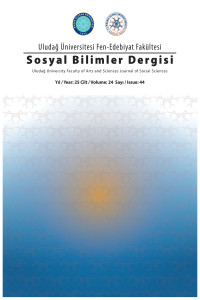Research Article
Year 2023,
Volume: 24 Issue: 44, 39 - 55, 31.01.2023
Abstract
Türk edebiyatında elif-nâmeler hemen her dönem tarihte ilgi duyulan ve örnekleri verilen bir konudur. Anlatımların çok daha çekici hâle getirilmesinin yollarından birisi olan bu manzumeler, harflerin hem şekil hem de anlam bakımından imge olarak kullanılmasıdır. Leb-değmez, muvaşşah, mühmel, mu’cem, hayfa, rakta gibi harf temelli söz sanatları, harflerin şekillerine göre benzetmeler yapılması ve ebced hesabı ile ilgili unsurlar harflerle ilgili özelliklerden yalnızca birkaçıdır. Edebî kaynaklarda ve özellikle tezkirelerde hayatı ve şahsiyeti hakkında bilgi bulunmayan Seyyid Ali Rûmî, Dürrü’l-Fu’âd ve Şeyhu’l-İrşâd adını verdiği hacimli eserinde kendisi ve eserleri hakkında ayrıntılı bilgiler sunmaktadır. Bu eserde bulunan iki elif-nâmesinde tasavvufî açıdan gönülden bağlı olduğu Abdülkadir Geylânî ve onun eserleri hakkında bilgileri manzum olarak anlatır. İkinci elif-nâmesinde ise, yaşadığı dönemdeki insanlarda bulunan ahlakî ve dinî zafiyetleri eleştirip, onlara yol gösterir. Aslında bir elif-nâme örneği olmayan üçüncü şiirinde kendisinin yazdığı eserlerin isimlerini yazıp, o risale ve kitapları tanıtır. Ne yazık ki Ali Rûmî’nin adı geçen eserleri günümüze kadar tespit edilememiştir.
References
- Ali Rûmî, Dürrü’l-Fu’âd ve Şeyhu’l-İrşâd (I). Marmara Üniversitesi İlahiyat Fakültesi Kütüphanesi. Yazmalar no. 31.
- Ali Rûmî, Dürrü’l-Fu’âd ve Şeyhu’l-İrşâd (II). Marmara Üniversitesi İlahiyat Fakültesi Kütüphanesi. Yazmalar no. 65.
- Arat, R. R. (1991). Eski Türk şiiri. Türk Tarih Kurumu Yayınları.
- Aycan, İ. (2004). Mervân. TDV İslâm Ansiklopedisi içinde (225-227. ss.), 29, TDV İslâm Araştırmaları Merkezi.
- Çelebioğlu, A. (1998). Eski Türk Edebiyatı araştırmaları. Milli Eğitim Bakanlığı Yayınları.
- Demirel, M. (1996). Âşık Paşa’nın elifnamesi ve dil özellikleri. Bilig, 3, 203-246.
- Eğri, S. (2022). Muhyiddin İbnü’l-Arabî’ye isnad edilen Tuhfetü’s-sefere ilâ hazreti’l-berere adlı eserin tercüme ve basımına Ali Rûmî tarafından yapılan manzum eleştiri. Uludağ Üniversitesi İlahiyat Fakültesi Dergisi, 31(1), 157-175.
- Güvenç, A. Ö. (2013). Latin alfabesine göre ortaya konan elifnameler üzerine. Turkish Studies, 8(13), 1003-1016.
- Harman, Ö.F. (2001). Kârûn. TDV İslâm Ansiklopedisi içinde (519-520. ss.), 24, TDV İslâm Araştırmaları Merkezi. Korkusuz, M. Ş. (1995), Gavsü’l-Azam Abdükadir Geylânî, Menzil Yayınevi.
- Öztoprak, N. (2006). Bursalı Feyzi Efendi’nin elifnameleri. İstanbul Üniversitesi Türk Dili ve Edebiyatı Dergisi, (35), 135-167.
- Öztoprak, N. (2009). Elif-nâmelerin tertip hususiyetleri ve metin tesisindeki yeri. Uluslararası Türklük Bilgisi Sempozyumu Bildirileri 2 içinde (817-829. ss.), Erzurum Atatürk Üniversitesi Yayınları.
- Taşkesenlioğlu, L. (2017). Divan Edebiyatında elifnameler ve bilinmeyen iki elifname örneği: Memi Can Saruhânî ve Ömer Karîbî elifnameleri. Atatürk Üniversitesi Türkiyat Araştırmaları Enstitüsü Dergisi, (58), 159-202.
- Uludağ, S. (1988). Abdülkâdir-i Geylânî. TDV İslâm Ansiklopedisi içinde (234-239. ss.), 1, TDV İslâm Araştırmaları Merkezi.
- Ümütlü, S. (2022). Nasihat-nâme geleneğine hacimli bir ek: Ali Baba Rûmî’nin Dürrü’l-Fu’âd Ve’ş-Şeyhü’l-İrşâd’ı. Eski Türk Edebiyatı Araştırmaları Dergisi, 5(1), 317-347.
- http://lugatim.com (2022, Eylül 26)
- https://tr.wikipedia.org/wiki/Abd%C3%BClk%C3%A2dir_Geyl%C3%A2n%C3%AE (2022, Ekim 1)
Year 2023,
Volume: 24 Issue: 44, 39 - 55, 31.01.2023
Abstract
In Turkish literature, elifnames are a subject that is of interest and examples are given in almost every period of history. These poems, which are one of the ways to make the narrations much more attractive, are the use of letters as images in terms of both shape and meaning. Letter-based rhetoric such as Leb-değiz, muvaşşah, mühmel, mu’cem, haifa, rakta, making analogies according to the shapes of letters, and elements related to abjad calculation are just a few of the features related to letters. Seyyid Ali Rûmî, who does not have information about his life and personality in literary sources and especially in tezkires, gives detailed information about himself and his works in his voluminous work called Dürrü’l-Fu’ad and Şeyhu’l-İrşâd. In the two elif-nâmes found in this work, he tells in verse about Abdülkadir Geylani, to whom he is deepl attached to Sufism, and his works. In his second elif-nâme, he criticizes the moral and religious weaknesses of the people of his time and guides them. In his third poem, which is not actually an example of an elif-nâme, he writes the names of the works he wrote and introduces those treatises and books. In fact, the mentioned works of Ali Rûmî have not been identified until today.
References
- Ali Rûmî, Dürrü’l-Fu’âd ve Şeyhu’l-İrşâd (I). Marmara Üniversitesi İlahiyat Fakültesi Kütüphanesi. Yazmalar no. 31.
- Ali Rûmî, Dürrü’l-Fu’âd ve Şeyhu’l-İrşâd (II). Marmara Üniversitesi İlahiyat Fakültesi Kütüphanesi. Yazmalar no. 65.
- Arat, R. R. (1991). Eski Türk şiiri. Türk Tarih Kurumu Yayınları.
- Aycan, İ. (2004). Mervân. TDV İslâm Ansiklopedisi içinde (225-227. ss.), 29, TDV İslâm Araştırmaları Merkezi.
- Çelebioğlu, A. (1998). Eski Türk Edebiyatı araştırmaları. Milli Eğitim Bakanlığı Yayınları.
- Demirel, M. (1996). Âşık Paşa’nın elifnamesi ve dil özellikleri. Bilig, 3, 203-246.
- Eğri, S. (2022). Muhyiddin İbnü’l-Arabî’ye isnad edilen Tuhfetü’s-sefere ilâ hazreti’l-berere adlı eserin tercüme ve basımına Ali Rûmî tarafından yapılan manzum eleştiri. Uludağ Üniversitesi İlahiyat Fakültesi Dergisi, 31(1), 157-175.
- Güvenç, A. Ö. (2013). Latin alfabesine göre ortaya konan elifnameler üzerine. Turkish Studies, 8(13), 1003-1016.
- Harman, Ö.F. (2001). Kârûn. TDV İslâm Ansiklopedisi içinde (519-520. ss.), 24, TDV İslâm Araştırmaları Merkezi. Korkusuz, M. Ş. (1995), Gavsü’l-Azam Abdükadir Geylânî, Menzil Yayınevi.
- Öztoprak, N. (2006). Bursalı Feyzi Efendi’nin elifnameleri. İstanbul Üniversitesi Türk Dili ve Edebiyatı Dergisi, (35), 135-167.
- Öztoprak, N. (2009). Elif-nâmelerin tertip hususiyetleri ve metin tesisindeki yeri. Uluslararası Türklük Bilgisi Sempozyumu Bildirileri 2 içinde (817-829. ss.), Erzurum Atatürk Üniversitesi Yayınları.
- Taşkesenlioğlu, L. (2017). Divan Edebiyatında elifnameler ve bilinmeyen iki elifname örneği: Memi Can Saruhânî ve Ömer Karîbî elifnameleri. Atatürk Üniversitesi Türkiyat Araştırmaları Enstitüsü Dergisi, (58), 159-202.
- Uludağ, S. (1988). Abdülkâdir-i Geylânî. TDV İslâm Ansiklopedisi içinde (234-239. ss.), 1, TDV İslâm Araştırmaları Merkezi.
- Ümütlü, S. (2022). Nasihat-nâme geleneğine hacimli bir ek: Ali Baba Rûmî’nin Dürrü’l-Fu’âd Ve’ş-Şeyhü’l-İrşâd’ı. Eski Türk Edebiyatı Araştırmaları Dergisi, 5(1), 317-347.
- http://lugatim.com (2022, Eylül 26)
- https://tr.wikipedia.org/wiki/Abd%C3%BClk%C3%A2dir_Geyl%C3%A2n%C3%AE (2022, Ekim 1)
There are 16 citations in total.
Details
| Primary Language | Turkish |
|---|---|
| Subjects | Creative Arts and Writing |
| Journal Section | Articles |
| Authors | |
| Publication Date | January 31, 2023 |
| Published in Issue | Year 2023 Volume: 24 Issue: 44 |

